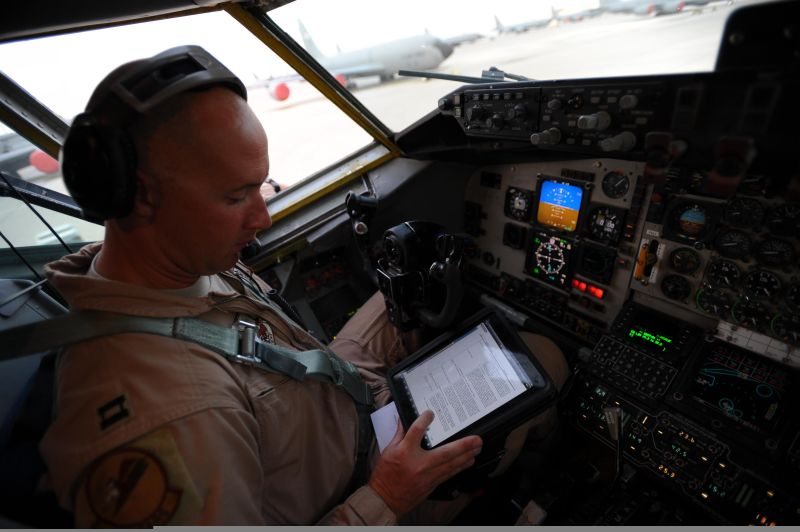Improved safety, operational effectiveness and efficiency are just a few reasons Air Mobility Command officials are looking into using tablet devices such as electronic flight bags for aircrew members reference materials in the cockpit during in-flight emergencies.
“Moving from a paper-based to an electronically-based flight publication system will not only enhance operational effectiveness, it can also save the Department of Defense time and money,” said Maj. Gen. Rick Martin, the AMC Director of Operations.
In coming months, AMC will be conducting an in-depth analysis of EFB implementation on multiple airframes based on earlier test results from a study at Travis Air Force Base, Calif.
Officials anticipate a final decision on the EFB initiative by early spring with the goal of using the devices across the total force mobility fleet.
As part of the DOD’s efficiency efforts, AMC is always on the lookout for innovative, cost-effective solutions that also enhance mission effectiveness, Martin said.
“Electronic flight bags are becoming an industry standard due to their operational, environmental and cost savings benefits,” Martin said.
“While AMC’s mission is similar to commercial carriers in several ways, we are examining every factor before we make a decision,” he said. “We must ensure that the technology not only augments our mission capability, but it would be employed to the maximum extent possible and that we implement appropriate control measures.”
According to Maj. Pete Birchenough, who heads AMC’s EFB test, the Mobility Air Forces fleet’s required flying charts are updated every 28 days.
“This equates to approximately 70 pounds of paper per aircraft each month that must be meticulously sorted, accounted for, and updated,” Birchenough said. “Accomplishing this one publication at a time requires considerable manpower and detracts from higher-priority tasks.”
Additionally, each crew member’s flight bag contains required technical orders, flight manuals and regulations and various other flight-related materials that add weight — burning fuel on each mission. With air mobility’s rigorous operations tempo, the elimination of 70 pounds of paper on each mission over time could add up to serious fuel savings.
“With limited space in the cockpit and the amount of paper that each crew has to manage, it can quickly become controlled chaos,” Birchenough said. “An electronic flight bag could solve this issue by putting all information in one place to be recalled and updated almost immediately.”
Another likely benefit is the reduction of flight publication printing and distribution costs.
An executive order released by the White House on Nov. 9 promotes efficient spending, partly by cutting printing costs: “Agencies are encouraged to limit the publication and printing of hard copy documents and to presume that information should be provided in an electronic form, whenever practicable.”
AMC officials estimate a timely return on investment for EFB tablet devices.
“The Air Force is historically devoted to efficiency, fully supports (the office of the secretary of defense) efforts and is committed to make every defense dollar count,” Martin said.
If test results reveal that an electronic flight publication system would enhance operational effectiveness and prove cost-effective, then AMC’s next step would be to seek an EFB device that best fits mission requirements.
“This is not a new initiative,” Martin said. “(Air Mobility Command) has been looking at tablet and mobile devices for several years as possible tools for increasing mission productivity, decreasing office automation costs and achieving other potential benefits such as portability and flexibility,” Martin said.
“As the evaluation process wraps up during the coming months, we’re going to scrutinize all information on the table to make the best decision for our operators and our future force,” he said.











